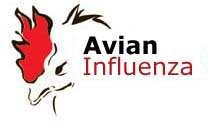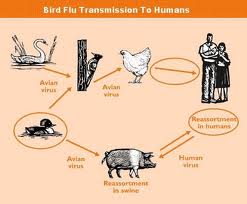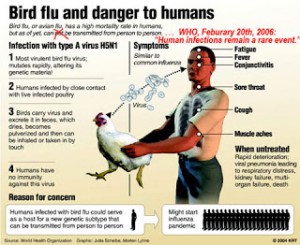Disconcerting headlines about avian influenza has caused widespread concern. Warnings have been issued to brace for an onslaught of a pandemic that could paralyze and decimate entire nations. Countries that showed cases of avian flu were scrutinized closely. Travel stopped to areas where poultry was affected. Despite reassurance to the consumer, buyers felt unsure about choosing chicken for dinner. It has been stated before, that at this point the virus of the avian flu has not made a mutation, and it is not passed from human to human. It can be transmitted from diseased fowl to human who are in close contact with the diseased animal.
The word pandemic seems to trigger a response of fear, but it has to be mentioned that a pandemic is not new. It is universally accepted that there have been 3 pandemics in the 20-th century. Pandemics are defined by an increased number of influenza deaths. One influenza wave hit in 1968, prior to this the year 1957 showed a similar picture. Pandemics are not all equal. The outbreak of influenza in 1918/19 was severe, and young and old were affected alike. Death was in many cases due to the primary viral infection.
In the meantime flu preparedness is much more common than in previous years. Flu shots are available, antibiotics can help treat secondary infection, laboratories are working on vaccines for new influenza strains, and lately antiviral medications have come into the picture.
While the work of scientists is invaluable, in some cases the statements are too simplistic. The avian flu virus H5N1 could mutate. Looking at the facts, the virus has been around since 1997, and it has not mutated. Reporters write stories about possible future pandemics, and there is worry in the population. They need to know the truth! The truth is that we should plan. The truth is also, that a pandemic is not more imminent today than it has been since 1918. In fact it is not more imminent than a multitude of other emergencies. The outbreak of SARS has shown that it is the front-line public health and hospital staff that handles the virus most of all. The production of vaccines and a strong vaccination program is being worked on. This does not leave the rest of the population with nothing what they can do.
Good hygienic measures have to be followed. The most important one (and often neglected one) is hand washing. It does not stop a pandemic like the one in 1918/19, but it certainly makes a difference to annual influenza rates. The annual vaccination against influenza is a highly effective weapon against the influenza outbreak that happens every year, and improved vaccines will make a difference between wellness and the opposite!
More information about:
The flu: http://nethealthbook.com/infectious-disease/respiratory-infections/flu/
The swine flu: http://nethealthbook.com/infectious-disease/respiratory-infections/swine-flu/
Reference: The Medical Post, June 20, 2006, page 47
Last edited Nov. 1, 2014








